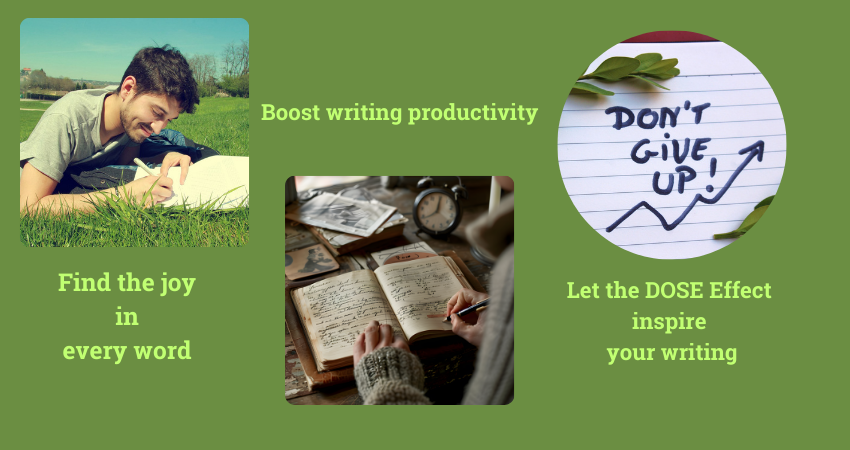While researching ways to boost writing productivity, I stumbled upon an inspiring concept that felt like an “aha” moment—a concept that resonated deeply with my own experiences as a writer/content writer. Often, we’re told to write more or push harder, but this framework called the DOSE Effect offered a refreshing perspective. It emphasizes the role of four neurochemicals—Dopamine, Oxytocin, Serotonin, and Endorphins—in cultivating effective and sustainable writing practices. As someone who has experienced both the highs of motivation and the lows of creative blocks, this idea felt like a bridge between science and the art of writing. Allow me to share this compelling approach with you.
Table of Contents
Toggle
What is the DOSE Effect
Dr. Andrew Huberman, a renowned neuroscientist, introduced the DOSE framework to explain how four key neurochemicals—Dopamine, Oxytocin, Serotonin, and Endorphins—impact our sense of motivation, joy, and well-being. This strategy has been backed by scientific research and offers a unique approach to building a productive and enjoyable writing routine. Let’s explore how each element of DOSE plays its part: DOSE Effect is rooted in neuroscience and highlights how these four key chemicals contribute to our sense of motivation, joy, and well-being. When harnessed deliberately, they can help us build a productive and enjoyable writing routine. Let’s explore how each element of DOSE plays its part.
Dopamine: The Reward Chemical
Dopamine fuels motivation by rewarding us when we achieve our goals, no matter how small. Imagine a writer who sets a modest goal of completing 100 words a day. Each time they hit that target, they take a moment to enjoy a cup of their favorite coffee or jot down their accomplishment in a success journal. Over time, these small rewards create a sense of achievement that keeps them motivated to return to their work each day. For writers, this means celebrating incremental progress. Finished a paragraph? Reward yourself. Hit your word count for the day? Pause to acknowledge it. These little moments of achievement can trigger dopamine release, encouraging you to keep going.
Actionable Tip: Break your writing tasks into smaller, manageable chunks. Each completed task will provide a dopamine boost, keeping you motivated.
Oxytocin: The Bonding Chemical
Oxytocin is often referred to as the “love hormone,” as it’s released when we feel connected to others. For writers, building these connections can look like attending workshops where ideas and techniques are shared, finding a mentor to guide you through challenges, or joining a local or virtual writing group. These spaces foster a sense of belonging and shared growth, turning writing into a collaborative and uplifting experience. Writing, while often solitary, can benefit greatly from community and connection.
Actionable Tip: Join a writing group, engage with fellow writers online, or share your work with a trusted peer. Feeling supported and understood can foster creativity and make the writing journey less lonely.
Serotonin: The Mood Stabilizer
Serotonin plays a critical role in mood regulation. Positive feelings about your writing practice can help you stay consistent over time. Reflecting on your progress and practicing gratitude for the ability to create can enhance serotonin levels. I remember a time when I struggled to stay motivated with my writing. At the end of each day, I began jotting down three things that made me proud—finishing a challenging sentence, discovering the perfect word, or simply sticking to my schedule despite distractions. Over time, this practice became a ritual. It wasn’t just about celebrating progress; it was about reconnecting with the joy of writing. This small habit transformed my mindset, making every writing session something I looked forward to instead of a task to dread.
Actionable Tip: Develop a habit of gratitude journaling—write down what went well in your writing session and how it made you feel. For instance, at the end of each session, list three specific things you accomplished, such as crafting a strong opening sentence, revising a tricky paragraph, or even sitting down to write despite distractions. Reflect on how these achievements made you feel, whether it’s pride, relief, or excitement. This practice not only boosts serotonin but also builds a positive association with your writing routine. This practice can boost your confidence and overall satisfaction.
Endorphins: The Natural Painkiller
Endorphins are released during physical activity or when we laugh, reducing stress and promoting a sense of well-being. Incorporating endorphin-releasing activities into your routine can indirectly enhance your writing practice.
Actionable Tip: Step away from your desk and move your body. A brisk walk, yoga session, or even a dance break can clear your mind and invigorate your creativity. You could also listen to your favorite music—something uplifting or calming—to elevate your mood and spark new ideas. Let the rhythm or lyrics guide your thoughts, creating a perfect blend of relaxation and inspiration.
Applying the DOSE Effect to Writing
To make the most of the DOSE Effect, let’s break it down into actionable and engaging steps that resonate with your writing journey:
- Start with Gratitude (Serotonin): Kick off your day with a quick gratitude practice. Reflect on what you love about writing or the joy of creating something unique. Acknowledge the progress you’ve made—even if it’s just a few sentences.
- Build Connections (Oxytocin): Writing doesn’t have to be a lonely endeavor. Join a writers’ group, participate in online forums, or attend local workshops. Sharing your work and receiving feedback can make the process collaborative and fulfilling.
- Start Small to Build Momentum (Dopamine): Begin your writing routine by setting achievable, bite-sized goals. Whether it’s completing a paragraph or brainstorming ideas, these small wins activate dopamine, fueling your motivation. Celebrate each step forward—even with a simple moment of acknowledgment or a small treat—to keep the momentum alive.
- Incorporate Movement (Endorphins): Step away from your desk to refresh your mind. A quick workout, a brisk walk, or even stretching can reduce stress and spark new ideas. Adding humor or a bit of playfulness to your routine can also release endorphins, keeping you energized.
By weaving these elements into your writing routine, you’ll create a practice that’s not only productive but also deeply enjoyable and sustainable. Remember, the goal isn’t just to write more but to make the journey meaningful and rewarding. Try implementing one or all of these steps and notice how it transforms your creative process. To make the most of the DOSE Effect, consider designing your writing routine around activities that naturally stimulate these chemicals. For instance, start your day with a short gratitude practice (serotonin), engage with your writing community (oxytocin), set small achievable goals (dopamine), and integrate movement or moments of joy (endorphins) into your schedule.
To Wrap Up
Writing can sometimes feel like an uphill battle, but the DOSE Effect reminds us that our brains are wired to support us. By understanding and leveraging these neurochemical boosts, you can create a writing habit that feels less like a chore and more like an act of joy and self-expression. Remember, every small step counts—celebrate them and watch how the DOSE Effect transforms not just your writing but your outlook on the creative process.
So why not give it a try? Whether you’re just starting your writing journey or looking to reignite your passion for the craft, the DOSE Effect might just be the spark you’ve been searching for. Happy writing!

Nice. Very well explained
I am glad you found it to be useful
Maya , your article hit me like a double expresso shot to the brain- sharp ,impactful and brilliantly written. I always look forward to reading your articles
Thank You Navjit